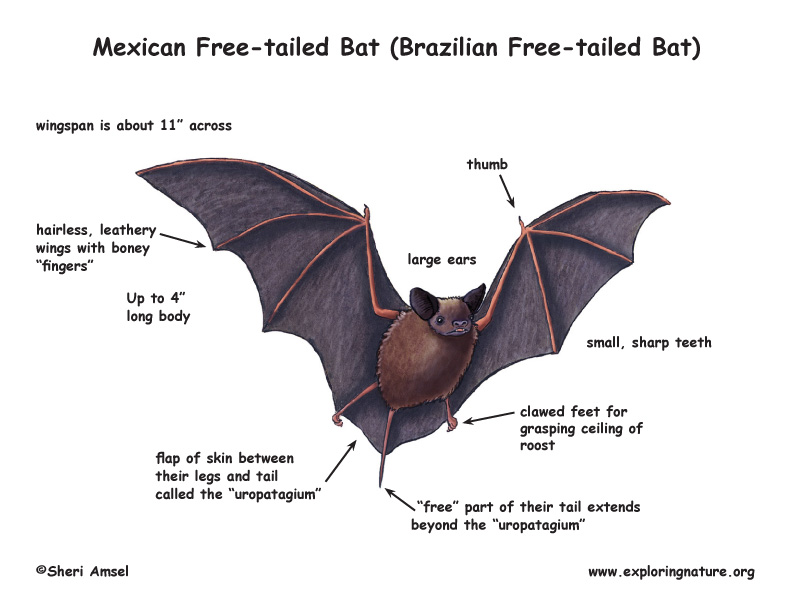

They are found throughout the southern U.S. (especially in the southwest), in Mexico, Central America and southwestern South America.
They roost in caves, buildings and under bridges.
They can reach up to 4” long and weigh up to only .5 oz. The “free” part of their tail extends beyond the flap of skin between their legs and tail (which is called the uropatagium). Their wingspan is about 11” across. They have large ears and a short snout.
They are nocturnal, hunting at night using echolocation. Echolocation is a kind of radar that uses the bat’s high pitched calls to bounce off objects. They can actually “see” what is around them by how their calls bounce off their surroundings. They are strong flyers and climbers. They live in large colonies and are thought to be very social bats, calling and interacting in their roost. Because their colonies are large, they often spread over a larger area to feed at night than other bat species. They migrate south in the fall and return north in spring to raise their young and feed on emerging insects.
They use echolocation to find prey. They eat insects (insectivorous) – mostly moths, but will also eat ants, flies, beetles, dragonflies, etc.
Predators include hawks, owls, raccoons, snakes and opossums.
Females are pregnant for 3 months (gestation). They have one pup in June. They are dependent on their mother for care and nursing for 1- 2 months. Females will form group of pups (called a creche), so they can leave them to feed. They find their pups to nurse by smell and call. They have just 1 pup a year.
They can live up to 10 years in the wild, but most live a much shorter time. They are exposed to pesticides because of their insect consumption, which can build up in their systems and cause a population decline. Roosting habitat disturbances can also affect populations.
Kingdom: Animalia
Phylum: Chordata
Subphylum: Vertebrata
Class: Mammalia
Order: Chiroptera
Family: Molossidae
Genus: Tadarida
Species: Tadarida brasiliensis
When you research information you must cite the reference. Citing for websites is different from citing from books, magazines and periodicals. The style of citing shown here is from the MLA Style Citations (Modern Language Association).
When citing a WEBSITE the general format is as follows.
Author Last Name, First Name(s). "Title: Subtitle of Part of Web Page, if appropriate." Title: Subtitle: Section of Page if appropriate. Sponsoring/Publishing Agency, If Given. Additional significant descriptive information. Date of Electronic Publication or other Date, such as Last Updated. Day Month Year of access < URL >.
Amsel, Sheri. "Bat (Mexican Free-tailed or Brazilian Free-tailed)" Exploring Nature Educational Resource ©2005-2024. December 13, 2024
< http://www.exploringnature.org/db/view/Bat-Mexican-Free-tailed-or-Brazilian-Free-tailed >

